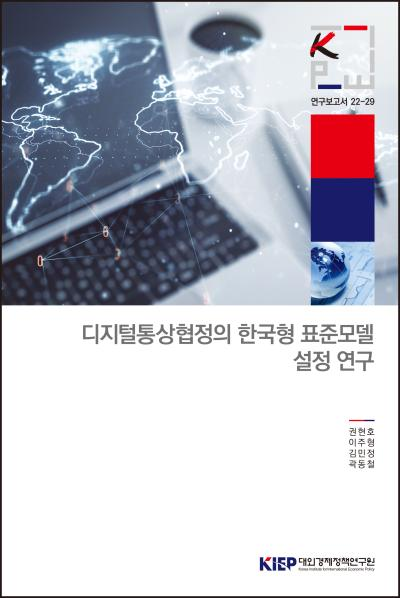Conference Proceedings
Publications
Conference Proceedings
To list

A Study on the Korean Model Law of Digital Trade Agreement
E-trade, electronic commerce
Author Hyunho Kwon, Joo Hyoung Lee, Minjung Kim, and Dongchul Kwak Series 22-29 Language Korean Date 2023.05.26
The purpose of this research is to provide necessary information to prepare a basic model law for the digital trade agreement that Korea will conclude. And more, this study analyzes the “forms and contents” of several digital trade agreements concluded so far, and presents practical considerations that need to be reviewed from a legal and policy perspective when Korea has a chance to conclude digital trade agreements in the future.
To this end, Chapter 2 presents specific grounds to establish the Korean digital trade agreement model at the formal or structural level. This is a formal and structural approach to consider for setting the model of digital trade agreements. To solve this problem, this study conducts a detailed review in two main aspects. First of all, the implications of the multilateral discussions on the digital trade agreement will be analyzed. Through this study, it is possible to examine the various forms or structures of digital trade agreements that appear in multilateral discussions themselves. On the other hand, what needs to be addressed in the process of forming a more realistic model is the formal aspect of digital trade agreements through bilateral, regional and plurilateral agreements or multilateral agreements. This approach will be the most realistic solution for Korea or most countries. In particular, there are various types for regulating digital trade through bilateral, regional and plurilateral agreements or multilateral agreements, such as those attached as part of FTAs or RTAs, and those concluded as independent trade agreements regardless of FTAs such as DEPA or KSDPA. Therefore, Chapter 2 presents various trade legal and policy implications, such as the meaning and characteristics of digital trade agreements concluded in different forms, and problems according to the legal perspectives of the agreement itself, which helps Korea set a model agreement.
In addition, the core of Chapter 3 is the analysis of the content aspects of digital trade agreements. Here, the content aspect refers to the degree of liberalization consequently raised in the composition and content of the agreement provisions that Korea should consider when signing a digital trade agreement. In other words, this aspect is connected to the degree of liberalization of the object in the conclusion of digital trade agreement. Therefore, Chapter 3 analyzes the contents of existing digital trade agreements, examines the specific and acceptable contents and scope that should be included in digital trade agreements from Korea’s point of view, and presents the basis for determining whether it can be discussed at the level of liberalization. The research topics in Chapter 3 are basically analyzing the current situation in the digital trade and examining the results and limitations of digital trade agreements that have already been implemented in the international relations. In particular, Chapter 3 provides the meaning and limitations of the digital trade agreement model to be concluded in the future based on the analysis of the contents of digital trade agreements made at the previous bilateral and regional levels.
As results of these studies, Chapter 4 of this research first evaluates existing digital trade agreements and proposes the direction of the model of digital trade agreements that Korea should maintain. In addition, as a result of this analysis, the characteristics of Korea’s digital trade agreement model are reviewed at the formal and content level, and the direction of the Korean digital trade agreement model is presented. Through this analysis, Chapter 4 classified the direction of the Korean model of digital trade agreements into the form of updating existing trade agreements, participating in open plurilateral agreements, and signing strategic digital partnership agreements, and analyzed their formal characteristics and implications for Korea. And as a result of this analysis, the model of the Korean digital trade agreement was presented by dividing it into a model based on traditional standards and a model based on the so-called ‘new standard.’
Finally, Chapter 5 completes the entire research by reviewing the problems that may arise in the future for digital trade. To this end, Chapter 5 proposes factors to be considered in terms of the maintenance of the domestic legal system according to the previously proposed Korean digital trade agreement model. In addition, in connection with the definition or scope of digital trade, Chapter 5 examines the problems or characteristics raised in the process of discussing the expansion of digital trade agreements into digital partnership agreements and further into digital economic agreements. And finally, Chapter 5 briefly examines legal policy problems that may be raised from the perspective of digital transformation, that is, the future transition to an industry that can be digitized in the future.
Sales Info
| Quantity/Size | 215 |
|---|---|
| Sale Price | 10 $ |
 공공저작물 자유이용허락 표시기준 (공공누리, KOGL) 제4유형
공공저작물 자유이용허락 표시기준 (공공누리, KOGL) 제4유형
대외경제정책연구원의 본 공공저작물은 "공공누리 제4유형 : 출처표시 + 상업적 금지 + 변경금지” 조건에 따라 이용할 수 있습니다. 저작권정책 참조
